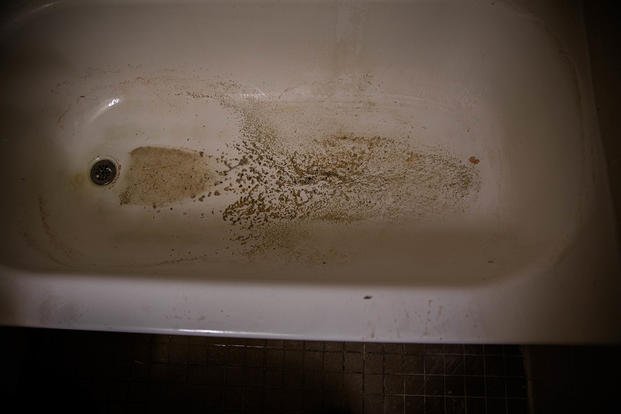The Army has finished major renovations and demolition of Fort Liberty, North Carolina's troubled Smoke Bomb Hill Barracks, which the service deemed unlivable after a slew of complaints from soldiers and media scrutiny.
Three barracks buildings were renovated and are set to house soldiers again in early 2024. But a dozen barracks were determined to be unsalvageable due to mold infestations and aging infrastructure. The Defense Department fast-tracked $82 million in contracts in September 2022 to renovate three buildings, and an additional $13.5 million contract to demolish 12 others.
The moves come after Military.com reported on the poor state of the barracks in August 2022, including senior Army officials' dismay over how local leadership had tolerated a rapidly deteriorating quality of life for soldiers stationed at the base, then known as Fort Bragg. The service quietly announced the renovations last week.
Read Next: Bodies of 3 Soldiers Recovered from Helicopter That Crashed into the Mediterranean Sea
"The Smoke Bomb Hill Barracks on Fort Liberty were identified to have life, health and safety issues due to systematic mechanical issues that resulted in a failure in humidity control, which increased the mold growth in the living spaces of the soldiers," Cheri Dragos-Pritchard, a spokesperson for the Army Corps of Engineers, wrote in a press release. "Those conditions could have negatively impacted the readiness of the XVIII Airborne Corps mission for a rapidly deployable force."
After senior leaders condemned the barracks, it triggered an unprecedented relocation of some 1,171 soldiers, putting an enormous strain on garrison logistics and marking one of the largest movements of soldiers outside of a mission in recent Army history. Nearly 300 of those troops were allowed to live off base.
Smoke Bomb Hill's closure served as a flash point over dilapidated living quarters for junior enlisted troops, a key quality-of-life concern that dominated media coverage of the Army. In some cases, mold has infested barracks to such a degree that soldiers have reported to Military.com about having to go to the emergency room for coughing up blood, difficulty breathing and other symptoms consistent with long-term exposure to mold.
Liberty garrison leaders knew numerous rooms were infested with mold, but action was taken only after direct complaints to Army Secretary Christine Wormuth and an inspection by now-retired Sgt. Maj. of the Army Michael Grinston, who then served as the top enlisted leader for the service. The complaints also came at a time when the Army was vocal about quality-of-life issues for soldiers, a priority that seems to have become less pronounced after a change in senior leadership.
Fort Liberty has been the only installation to move troops en masse due to mold or other infrastructure issues. A 2022 investigation by Military.com found that Fort Stewart, Georgia's barracks are in equally bad or possibly worse shape, but local leadership said there are no plans to move residents -- though in some cases, soldiers who have been treated for health ailments have been relocated.
After Military.com's investigation, the Army inspected all of its active-duty barracks, finding 2,100 had some sort of mold issue. Of those, 390 barracks are in "poor or failing" condition, according to internal service documents reviewed by Military.com.
Funding is at the heart of the issue. Army planners estimate it would cost $7.5 billion simply to catch up on maintenance and repair backlogs for soldier housing, particularly in humid parts of the country including North Carolina, Georgia and Hawaii.
The Army has a relatively small $1 billion annual budget to maintain and build new barracks, with some projects at Fort Cavazos, Texas, and Fort Carson, Colorado, projected to open within the next three years. Though the Army aims to fully fund maintenance, Wormuth told Military.com in October, the service in recent years has taken roughly 15% of its maintenance budget for barracks and diverted it to other, unrelated priorities.
Even without diverting the funds, fully funding maintenance would add only about $343 million to the barracks budget overall through the rest of the decade -- essentially pocket change for the Army that doesn’t account for the likely rise of labor and construction costs.
Lawmakers in states with a large military presence have since asked all of the services to figure out a price tag to catch up on all renovations and construction, something the Army has been gun-shy about as it juggles demands such as running expensive Combat Training Centers and expanding its footprint in the Pacific.
Army leaders within the last month held a meeting on future plans for barracks, including potential new policies and construction efforts, but nothing has been formalized, Maj. Gen. John Rafferty, the chief of Army public affairs, told Military.com.
Related: Mold Is Consuming Fort Stewart's Barracks as a Pattern Emerges Across the Army












